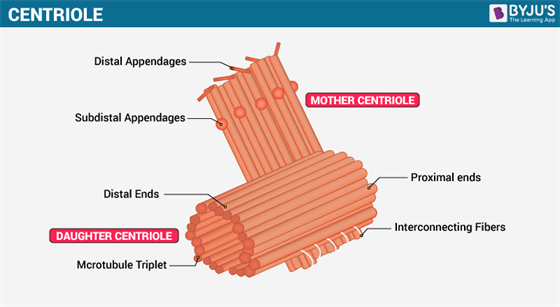Centriole Definition
“Centriole is an organelle, cylindrical in shape, that is composed of a protein called tubulin.”
What is Centriole?
All animal cells have two centrioles. They help the cell during cell division. They work during the process of mitosis and meiosis. They could be found in some lower plants such as Chlamydomonas, although they are not present in many of the fungi, angiosperms (flowering plants) and pinophyta (conifers). They are usually present near the nucleus but are not visible when the cell is not dividing.
Let us have a detailed look at centrioles structure and its function.
Also Read: Cell organization
Centrioles Structure

Centrioles Structure
All the centrioles are formed of 9 groups of microtubule triplets organized in a cylindrical shape. The detailed structure of centrioles can be studied only under an electron microscope. These are associated together at right angles to each other.
The embryo of Drosophila melanogaster and C. elegans are exceptions to this organization. The former forms 9 pairs instead of microtubule triplets, whereas the premature embryos and sperm cell of C. elegans have 9 single microtubules.
Edouard van Beneden and Theodor Boveri observed and identified the centrioles for the first time in 1883 and 1888. The structure of duplication of centrioles was first given by Joseph G. Gall and Etienne de Harven in the 1950s.
Centriole helps in organizing the mitotic spindle and complete the process of cytokinesis. However, centrioles were believed to be necessary for the formation of the mitotic spindle in the animal cell. Although, several recent types of research have explained that the cell which does not have a centriole (surgically removed through laser) can function without it in the G1 level of interphase and can be formed later in a de novo manner.
The location of the centrioles plays a key role in the three-dimensional organization of the cell as it also regulates the location of the nucleus.
In flagellated and ciliated organisms the location of such organelle is decided after the mother centrioles that form the base.
Also Read: Cell Organelles
Centrioles Function
Following are the important centrioles function:
- In spite of being devoid of DNA, the centrioles are capable of forming new centrioles.
- They can be transformed into basal bodies.
- The basal bodies give rise to flagella and cilia.
- They help in cell division by forming microtubule organising centres.
- Out of the two centrioles, the distal centriole forms the tail or axial filament.
Also Read: Centrosome
To learn about centrioles, its structure and function, keep visiting BYJU’S website or download BYJU’S app for further reference.
Frequently Asked Questions
What is the role of a centriole in a cell?
The centriole is concerned with the cell division. They help in the formation of spindle fibres that separate the chromosomes during the cell cycle.
How does a centriole look like?
A centriole comprises nine bundles of microtubules that are hollow tubes arranged in a ring. It appears to be cylindrical in shape.
How is a centriole different from a centrosome?
The centrosome is made up of two centrioles. On the contrary, centrioles are the microtubules that make the centrosome. Centrosome produces spindle fibres during cell division.
Why are centrioles important?
Centrioles are involved in organizing microtubules in the cytoplasm. The position of centriole is responsible for the position of the nucleus and is responsible for the spatial arrangement of the cell. Hence, they are crucial for cell division.
Who discovered centrioles?
Centrioles were discovered by Boveri and Edouard Van Beneden in the animal cells.
Do plant cells have a centriole?
The centriole is only found in animal cells and in a few lower plants such as Chlamydomonas. They are however absent in all the higher plants.
How do higher plants divide without centrioles?
In the higher plants, mitosis occurs with the help of microtubules forming spindle fibres without the help of centrioles. They develop spindle fibres at centriolar centrosomes, polar organizers, plastid MTOCs or nuclear envelope MTOCs.

Comments